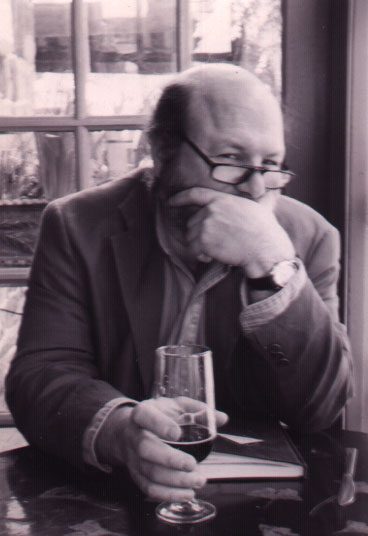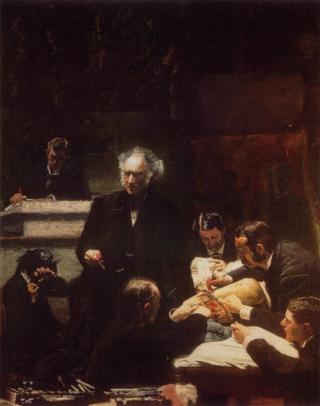 |
Bentzman Suburban Soliloquy 105. The Gross Clinic |
 |
Bentzman Suburban Soliloquy 105. The Gross Clinic |
| The last time I saw The
Gross Clinic was two months ago. My friend Kurt
from Louisiana was in Philadelphia on business. We knew
each other only from letters. It was our first
face-to-face meeting and I gave him a little tour of the
city, which included a lunch of Peking duck in Chinatown
and a visit to Eakins' painting at the Jefferson Alumni
Hall. The eight-foot high painting is of Doctor Samuel D. Gross, one of the school's historically famous surgeons, and shows him engaged in surgery. Jefferson alumni paid two hundred dollars for the painting in 1878 and gave it to their alma mater. Philippe de Montebello, Director of the Metropolitan Museum of Art, has acknowledged that Eakins "is recognized as one of America's foremost painters...." The Gross Clinic is regarded by many art historians to be the greatest American painting.  I get a thrill from taking people to see the Eakins' masterpiece. No one expects it, this famous painting tucked away as if in concealment. There are no lines of visitors, no tickets to purchase, you simply request access from the security guard at the front desk and one is given a private viewing. The guard will lead you down the hallway to the gallery, unlock it, and, if it's the right security guard, will even act as docent. He will tell you how Eakins took anatomy classes at Jefferson Medical College, had dissected cadavers for no other reason than to become a better painter. It was especially rewarding to take Kurt to see it. He loves art and he knew the painting by reputation and reproduction, but he had no idea he was about to see it. He had expected it to be in a major museum. "Is it a copy?" he asked. Thomas Jefferson University and Hospital has sold the The Gross Clinic for $68 million. The first notice in the press that Ms Keogh, my more significant other, and I saw announced that the painting had been bought by the National Gallery of Art in Washington, D.C. Ms Keogh and I agreed this was not entirely bad news. The painting would get more exposure in the National Gallery and it deserved more exposure. But then we learned further details. The painting would be jointly owned by the National Gallery and the Crystal Bridges Museum of American Art in Bentonville, Arkansas. The Crystal Bridges Museum of American Art was founded by Alice Walton, one of the richest people in the world, the daughter of Sam Walton, the founder of Wal-Mart. The museum is under construction and is not expected to open until 2009. The news brought Ms Keogh to tears. Neither of us wanted to see the painting moved so far away. Nor were we happy with the association to Wal-Mart, a corporation that has undermined the U.S. workforce by exploiting labor both here and overseas. We didn't want to see the painting bought by Alice Walton, a contributor to conservative causes and candidates, the very kind of priggish people that hurt Thomas Eakins' career. A native son of Philadelphia, Thomas Cowperthwaite Eakins, born 25th July 1844, was fortunate to have parents supportive of his interest in art. From his father he learned calligraphy, his father an instructor of calligraphy. The first spark of his lifelong interest in the sciences and art came at Philadelphia's Central High School (1857-1861) where he learned draftsmanship. Self-taught from art books, he ventured off to draw and paint the countryside during the Civil War with artist friends. Eakins' father paid to have someone else to serve in the Union army in his son's place. In 1862, Thomas entered the Pennsylvania Academy of the Fine Arts and registered to observe demonstrations in anatomy and surgery at Jefferson Medical College. He lived in Philadelphia most of his life and he died here 25th June 1916. Ms Keogh has visited his grave, which had been unmarked until a student insisted on having a headstone made for his beloved teacher. Several Sundays ago, Ms Keogh and I drove into Philadelphia to join what we thought would be a mass gathering of demonstrators converging in front of the Jefferson Alumni Hall. There was no one out front. We found them at the end of the block, the corner of Locust and 11th Street. As we approached, we were sadly disappointed to see less than two dozen demonstrators. Where were the students of the local art schools, the Art Institute of Philadelphia, Tyler School of Art, Moore College of Art and Design, University of the Arts? Are Philadelphians Philistines? Why weren't they demonstrating to retain this important legacy? It was a cold day, only a strip of sunlight managed to slip through the narrow streets sideways and there was a chilly wind that made it difficult to tote signs and display a banner. I admit, I wondered to myself if Philadelphia deserved to keep The Gross Clinic. Few Philadelphians knew about it or cared about it. It received few visitors. The city certainly wasn't kind to Thomas Eakins. Thomas Eakins was considered scandalous in his day. His sin was using nude models in mixed-sex classes. The happy ending to this story is that the city did wake up. Thomas Eakins and this painting are braided into the city's history. Philadelphia did not want to lose this heritage. Philadelphia Mayor Street and Pennsylvania Governor Rendell vowed to keep it in Philadelphia. The Annenberg Foundation donated $10 million, the Pew Charitable Trusts, H.F. Lenfest, and Joseph Neubauer each donated $3 million, and over 2,000 donations came in from thirty states and the District of Columbia. Celebrities gave their name to the cause. Thomas Jefferson University had originally given the city 45 days, until 26th December, to raise a matching $68 million. With nearly half the amount raised, and the University extending the time limit to the end of January, Wachovia Bank has agreed to loan the city whatever the remainder needed. The painting will not leave the city. The Gross Clinic will now alternately hang at the Philadelphia Museum of Art and the Pennsylvania Academy of the Fine Arts, the latter being not only Eakins' alma mater, but the place where he was later professor of drawing and painting, and then forced by the prudish to resign. Bruce Bentzman Addendum: |
This essay is the most recent in
a series of regular reports from the life and times of Mr
Bentzman. If you've any comments or suggestions, the
writer would be pleased
to hear from you.
Mr Bentzman's
collection of poems, "Atheist Grace" is available from Amazon, as are "The Short Stories
of B.H.Bentzman"